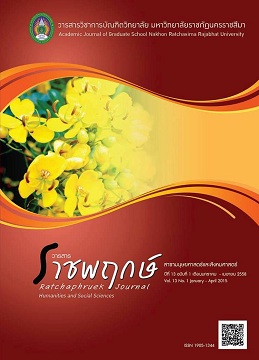Effects of Instructional Model on Concept Attainment in Mathematicson “SET” of the Tenth Grade Students
Main Article Content
Abstract
The purposes of this research were to study effects of attainment model’s concept of instruction and conceptual thinking ability and to compare learning achievement of mathematics “Set” and conceptual thinking ability of the tenth grade students between the group learning by a concept attainment model and the group learning by IPST teaching model. The subject was 89 tenth grade students at Datdaruni school in Chachoengsao province. Forty-five students were in the experimental group and forty-four students were in the controlled group. There were two categories of research instruments. The data collection instruments were mathematics “set” achievement test and conceptual thinking ability test. The experimental instruments were lesson plans of mathematics “set”. The duration of experiment was six weeks, total of twelve periods. The collected data were analyzed by arithmetic means () standard deviation (S.D.), t-test (Independent-Samples).
The research findings were summarized as follows:
1. Students learning by concept attainment model obligated mathematics “set” achievement were scores more than 60 percent of the total score and equal or more 60 percent of experimental group.
2. Students learning by concept attainment model obligated the learning achievement of mathematics “set” higher than students learning by IPST teaching model at.05 level of significance.
3. Students learning by concept attainment model gained conceptual thinking ability higher than students learning by IPST teaching model at.05 level of significance.
Article Details
References
กัญติมา พรหมอักษร. (2545). ผลของปฏิสัมพันธ์ระหว่างแบบการคิดของนักเรียนกับ แบบการสอนมโนทัศน์ของบรุนเนอร์ที่มีต่อผลสัมฤทธิ์ในวิชาคณิตศาสตร์ ของนักเรียนชั้นประถมปีที่ 5.วิทยานิพนธ์มหาบัณฑิต สาขาจิตวิทยาการศึกษา คณะครุศาสตร์ จุฬาลงกรณ์มหาวิทยาลัย.
เฉลิมลาภ ทองอาจ. (2550). ผลของการใช้รูปแบบการสอนมโนทัศน์ที่มีต่อผลสัมฤทธิ์การเรียนรู้ หลักการใช้ภาษาไทยและความสามารถในการคิดเชิงมโนทัศน์ของนักเรียนชั้นมัธยมศึกษาปีที่ 2. วิทยานิพนธ์มหาบัณฑิต สาขาวิชาการสอนภาษาไทย บัณฑิตวิทยาลัย จุฬาลงกรณ์มหาวิทยาลัย.
ทิศนา แขมมณี. (2553). ศาสตร์การสอน : องค์ความรู้เพื่อการจัดกระบวนการเรียนรู้ที่มีประสิทธิภาพ. พิมพ์ครั้งที่ 12. กรุงเทพฯ : สำนักพิมพ์แห่งจุฬาลงกรณ์มหาวิทยาลัย.
ปราณี พรภวิษย์กุล. (2549). ผลของการจัดกิจกรรมการสอนคณิตศาสตร์โดยใช้โมเดลการสร้างมโนทัศน์ที่มีต่อมโนทัศน์ทางคณิตศาสตร์และความคงทนในการเรียนคณิตศาสตร์ของนักเรียนชั้นประถมศึกษาปีที่ 5. วิทยานิพนธ์มหาบัณฑิต สาขาวิชาการสอนคณิตศาสตร์ บัณฑิตวิทยาลัย จุฬาลงกรณ์มหาวิทยาลัย.
วรนุช มูลกาย. (2548). การพัฒนากิจกรรมการเรียนการสอนกลุ่มสาระการเรียนรู้สังคมศึกษาศาสนาและวัฒนธรรม โดยใช้รูปแบบการสอนมโนทัศน์สำหรับนักเรียนชั้นมัธยมศึกษาปีที่ 2. วิทยานิพนธ์มหาบัณฑิต สาขาหลักสูตรและการสอน บัณฑิตวิทยาลัย มหาวิทยาลัยราชภัฏอุดรธานี.
สถาบันส่งเสริมการสอนวิทยาศาสตร์และเทคโนโลยี. (2555). ครูคณิตศาสตร์มืออาชีพ. กรุงเทพฯ : 3-คิว มีเดีย.
สาคร เกษม. (2544). ผลสัมฤทธิ์ทางการเรียนคณิตศาสตร์ของนักเรียนชั้นประถมศึกษาปีที่ 2 ที่เรียนโดยใช้รูปแบบการสร้างความคิดรวบยอด. วิทยานิพนธ์ศึกษาศาสตรมหาบัณฑิต สาขาวิชาประถมศึกษา บัณฑิตวิทยาลัยมหาวิทยาลัยเชียงใหม่.
สิริทิพย์ พูลศรี. (2542). ผลของการใช้รูปแบบการสร้างความคิดรวบยอด ที่มีผลต่อผลสัมฤทธิ์ทางการเรียนคณิตศาสตร์ของนักเรียนชั้นประถมศึกษาปีที่ 5. วิทยานิพนธ์ศึกษาศาสตรมหาบัณฑิต สาขาประถมศึกษา บัณฑิตวิทยาลัย มหาวิทยาลัยเชียงใหม่.
อัมพร ม้าคนอง. (2546). คณิตศาสตร์ : การสอนและการเรียนรู้. กรุงเทพฯ : โรงพิมพ์แห่งจุฬาลงกรณ์มหาวิทยาลัย.
Arends, R. I. (2001). Learning to teach. 5th ed. Boston : McGraw-Hill.
Carroll, W. (2007). The concept attainment model. [Online]. Available : http://www.lcsc.education/secondary/Courses/ED454/Lessons/OnCampus 06 Chapter5.pdf [2011, Aug 29].
Crisman. F. N. (1984). A comparison of oral and written techniques of concept instruction to students of students of different learning styles. [Online]. Available : :http://proquest.umi.com/pqdweb?index=66&did=75254995&SrchMode 1&sid=2&Fmt2&lnst=PROD&VType=PQD&RQT=309&Vname=PQD&TS=1180413410&clientld=12345 [2011, June 26].
Gunter, M. A., T. H. Estes and J. Schwab. (1995). Instruction : A Models Approach. 2nd ed. Boston : Allyn and Bacon.
Joyce. M. and M. Weil. (2000). Models of teaching. 6th ed. Boston : Allyn and Bacon.
Johnson, J. and Others. (1992). Developing conceptual thinking : The concept attainment model. [Online]. Available : http://searh.ebscohost.com/login.aspx?direct=ture&db=eric&AN=EJ465234&s ite=ehost-live [2011, May 14].
Lamm, H. A. (1993). Comparison of two teaching strategies on post-secondary development a mathematics student. [Online]. Available : http://proquest.umi.com/pqdweb?index=7&did=747668501&SrchMode=1&sid =4&Fm=2&Vlnst=PROD&VType=PQD&RQT=309&VName=PQD&TS=1180413523&clientld=12345 [2011, May 25].
Louvet, M. C. (1988). Learning Via the Socratic Method : The Use of The Concept Attainment Model in Foreign Language Classes. [Online]. Available : http://www.eric.ed.gov/ERICWebPortal/custom/portlets/recordDetails
Reed, S. K. (2007). Cognition theory and application. 7th ed. Australia : Tomson/Wadswoth.
Smith, B. D. (1998). Psychology science & understanding. Boston : McGraw-Hill.
Smith,P. L. and T. J. Ragan. (2005). Instructional design. 3rd ed. Boston : John Wiley &Sons.
Sreelekha, S. and N. Ajitha. (2004). The effectiveness of concept attainment model (cam) in learning chemistry at secondary level. [Online]. Available : http://ncert.in/sites/publiccation/j3sch_sc_4Htm [2011, October 12].


